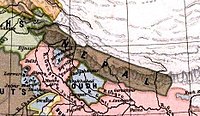| Nepalese royal massacre | |
|---|---|
 The Narayanhiti Palace, former home of the royal family. Following the abdication of the king and the founding of a republic, the building and its grounds have been turned into a museum. | |
| Location | Tribhuvan Sadan, Narayanhiti Durbar, Kathmandu, Nepal |
| Coordinates | 27°42′56″N 85°19′12″E / 27.7156°N 85.32°E |
| Date | 1 June 2001 (19 Jestha 2058 Nepal B.S.) Around 21:00 (UTC+05:45) |
| Target | The Nepalese royal family |
Attack type | Mass shooting, familicide, regicide, murder suicide |
| Weapons |
|
| Deaths | 10 (including the perpetrator) |
| Injured | 5 |
| Perpetrator | Crown Prince Dipendra of Nepal[2] |
| History of Nepal |
|---|
 |
|
|
The Nepalese royal massacre (also called “Durbar Hatyakanda”) occurred on 1 June 2001 at the Narayanhiti Palace, the then-residence of the Nepali monarchy. Nine members of the royal family, including King Birendra and Queen Aishwarya, were killed in a mass shooting during a gathering of the royal family at the palace.[3] A government-appointed inquiry team named Crown Prince Dipendra as perpetrator of the massacre.[4] Dipendra slipped into a coma after shooting himself in the head.[5]
Dipendra was declared King of Nepal while comatose after murdering his father and brothers. He died in hospital three days after the massacre without regaining consciousness. Birendra's brother Gyanendra then became king.[6]
- ^ "Wrap royal shootings inquiry complete + Dipendra ceremony". YouTube (YouTube video). Associated Press. 21 July 2015. Archived from the original on 4 November 2023. Retrieved 4 November 2023.
- ^ Birendra Bir Bikram Shah Dev at the Encyclopædia Britannica.
- ^ "Death, Love and Conspiracy: The Nepalese Royal Massacre of 2001 (Durbar Hatyakanda)". Association for Diplomatic Studies & Training. Archived from the original on 31 March 2023. Retrieved 3 May 2022.
- ^ "Bodyguards fired over Nepal royal massacre". The Irish Times. 3 July 2001. Archived from the original on 25 April 2020. Retrieved 19 November 2019.
- ^ Cite error: The named reference
Massacrewas invoked but never defined (see the help page). - ^ "Dipendra was innocent: witness". The Indian Express. 24 July 2008. Archived from the original on 30 September 2013. Retrieved 29 May 2012.